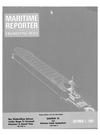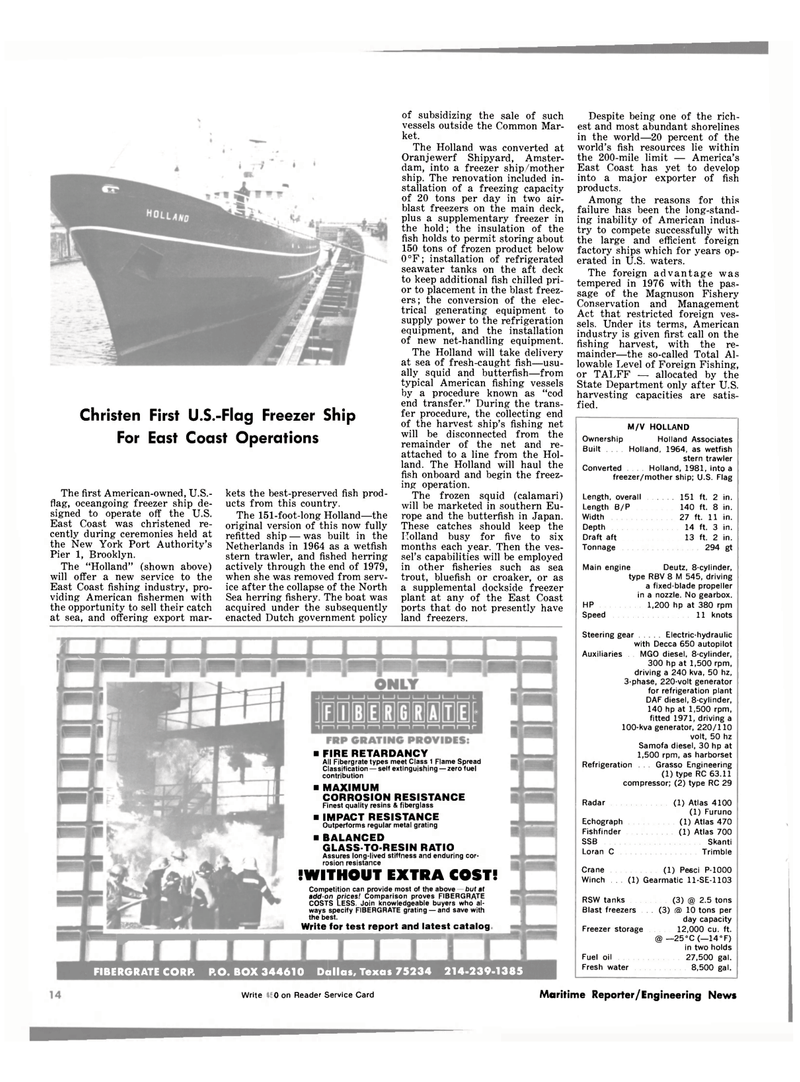
Page 10: of Maritime Reporter Magazine (October 1981)
Read this page in Pdf, Flash or Html5 edition of October 1981 Maritime Reporter Magazine
Christen First U.S.-Flag Freezer Ship
For East Coast Operations
The first American-owned, U.S.- flag, oceangoing freezer ship de- signed to operate off the U.S.
East Coast was christened re- cently during ceremonies held at the New York Port Authority's
Pier 1, Brooklyn.
The "Holland" (shown above) will offer a new service to the
East Coast fishing industry, pro- viding American fishermen with the opportunity to sell their catch at sea, and offering export mar- kets the best-preserved fish prod- ucts from this country.
The 151-foot-long Holland—the original version of this now fully refitted ship — was built in the
Netherlands in 1964 as a wetfish stern trawler, and fished herring actively through the end of 1979, when she was removed from serv- ice after the collapse of the North
Sea herring fishery. The boat was acquired under the subsequently enacted Dutch government policy of subsidizing the sale of such vessels outside the Common Mar- ket.
The Holland was converted at
Oranjewerf Shipyard, Amster- dam, into a freezer ship/mother ship. The renovation included in- stallation of a freezing capacity of 20 tons per day in two air- blast freezers on the main deck, plus a supplementary freezer in the hold; the insulation of the fish holds to permit storing about 150 tons of frozen product below 0°F; installation of refrigerated seawater tanks on the aft deck to keep additional fish chilled pri- or to placement in the blast freez- ers ; the conversion of the elec- trical generating equipment to supply power to the refrigeration equipment, and the installation of new net-handling equipment.
The Holland will take delivery at sea of fresh-caught fish—usu- ally squid and butterfish—from typical American fishing vessels by a procedure known as "cod end transfer." During the trans- fer procedure, the collecting end of the harvest ship's fishing net will be disconnected from the remainder of the net and re- attached to a line from the Hol- land. The Holland will haul the fish onboard and begin the freez- ing operation.
The frozen squid (calamari) will be marketed in southern Eu- rope and the butterfish in Japan.
These catches should keep the
Holland busy for five to six months each year. Then the ves- sel's capabilities will be employed in other fisheries such as sea trout, bluefish or croaker, or as a supplemental dockside freezer plant at any of the East Coast ports that do not presently have land freezers. • FIRE RETARDANCY
All Fibergrate types meet Class 1 Flame Spread
Classification — self extinguishing — zero fuel contribution • MAXIMUM
CORROSION RESISTANCE
Finest quality resins & fiberglass • IMPACT RESISTANCE
Outperforms regular metal grating • BALANCED
GLASS-TO-RESIN RATIO
Assures long-lived stiffness and enduring cor- rosion resistance
WITHOUT EXTRA COST!
Competition can provide most of the above add-on prices! Cc but at omparison proves FIBERGRATE
COSTS LESS. Join knowledgeable buyers who al- ways specify FIBERGRATE grating — and save with the best.
Write for test report and latest catalog
Despite being one of the rich- est and most abundant shorelines in the world—20 percent of the world's fish resources lie within the 200-mile limit — America's
East Coast has yet to develop into a major exporter of fish products.
Among the reasons for this failure has been the long-stand- ing inability of American indus- try to compete successfully with the large and efficient foreign factory ships which for years op- erated in U.S. waters.
The foreign advantage was tempered in 1976 with the pas- sage of the Magnuson Fishery
Conservation and Management
Act that restricted foreign ves- sels. Under its terms, American industry is given first call on the fishing harvest, with the re- mainder—the so-called Total Al- lowable Level of Foreign Fishing, or TALFF — allocated by the
State Department only after U.S. harvesting capacities are satis- fied.
FIBERGRATE CORP. P.O. BOX 344610 Dallas, Texas 75234 214-239-1385
M/V HOLLAND
Ownership . Holland Associates
Built Holland, 1964, as wetfish stern trawler
Converted Holland, 1981, into a freezer/mother ship; U.S. Flag
Length, overall . 151 ft. 2 in.
Length B/P 140 ft. 8 in.
Width 27 ft. 11 in.
Depth 14 ft. 3 in.
Draft aft 3 ft. 2 in.
Tonnage 294 gt
Main engine Deutz, 8-cylinder, type RBV 8 M 545, driving a fixed-blade propeller in a nozzle. No gearbox.
HP 1,200 hp at 380 rpm
Speed 11 knots
Steering gear Electric-hydraulic with Decca 650 autopilot
Auxiliaries MGO diesel, 8-cylinder, 300 hp at 1,500 rpm, driving a 240 kva, 50 hz, 3-phase, 220-volt generator for refrigeration plant
DAF diesel, 8-cylinder, 140 hp at 1,500 rpm, fitted 1971, driving a 100-kva generator, 220/110 volt, 50 hz
Samofa diesel, 30 hp at 1,500 rpm, as harborset
Refrigeration Grasso Engineering (1) type RC 63.11 compressor; (2) type RC 29
Radar (1) Atlas 4100 (1) Furuno
Echograph (1) Atlas 470
Fishfinder (1) Atlas 700
SSB Skanti
Loran C Trimble
Crane . . (1) Pesci P-1000
Winch (1) Gearmatic ll-SE-1103
RSW tanks (3) @ 2.5 tons
Blast freezers (3) © 10 tons per day capacity
Freezer storage 12,000 cu. ft. @ —25°C (—14°F) in two holds
Fuel oil 27,500 gal.
Fresh water 8,500 gal. 12
Write 210 on Reader Service Card Maritime Reporter/Engineering News

 9
9

 11
11
